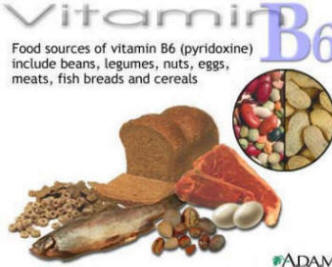Vitamin B-6 deficiency

Definitiontions that involve amino acids. Vitamin B6 deficiency is rare, since most foods eaten contain the vitamin.
Description
Vitamin B6 is a water-soluble vitamin. The recommended dietary allowance (RDA) for vitamin B6 is 2.0 mg/day for the adult man and 1.6 mg/day for the adult woman. Vitamin B6 in the diet generally occurs as a form called pyridoxal phosphate. In this form, it cannot be absorbed by the body. During the process of digestion, the phosphate group is removed, and pyridoxal is produced. However, the body readily absorbs pyridoxal, and converts it back to the active form of the vitamin (pyridoxal phosphate).
Poultry, fish, liver, and eggs are good sources of vitamin B6, comprising about 3-4 mg vitamin/kg food; meat and milk contain lesser amounts of the vitamin. The vitamin also occurs, at about half this level, in a variety of plant foods, including beans, broccoli, cabbage, and peas. Vitamin B6 tends to be destroyed with prolonged cooking, with storage, or with exposure to light.
As mentioned, vitamin B6 takes various forms. One of these forms, called pyridoxine, is relatively stable. For this reason, pyridoxine is the form of vitamin B6 that is used in vitamin supplements, or when foods are fortified. Apples and other fruits are poor sources of the vitamin, containing only 0.2-0.6 mg vitamin/kg food.
Vitamin B6, used mainly in the body for the processing of amino acids, performs this task along with certain enzymes. The enzyme that participates in this type of complex is aminotransferase. Several types of aminotransferase exist. With vitamin B6 deficiency, while aminotransferase continues to occur in the various organs of the body, there is an abnormally low level of the active vitamin B6/aminotransferase complex present. Thus, this vitamin deficiency results in the impairment of a variety of activities in the body. With supplement correction of the vitamin B6 deficiency, the aminotransferase then readily forms the active complex, and normal metabolism is restored.
Vitamin B6 converts certain amino acids (glutamic acid, aspartic acid, glycine) to energy. This allows the body to process all dietary protein, even when the dietary protein is in excess of the body's needs. Vitamin B6 also allows the body to synthesize certain amino acids. For example, if the diet is deficient or low in certain amino acids, such as glycine or serine, vitamin B6 enables the body to make them from sugar. Vitamin B6 is used also for the synthesis of certain hormones, such as adrenaline.
Causes and symptoms
Vitamin B6 deficiency occurs rarely. When it does, it is usually associated with poor absorption of nutrients in the gastrointestinal tract (as in alcoholism, or with chronic diarrhea), the taking of certain drugs (as isoniazid, hydrolazine, penicillamine) that inactivate the vitamin, with genetic disorders that inhibit metabolism of the vitamin, or in cases of starvation.
The symptoms of vitamin B6 deficiency in adults are only vaguely defined. These include nervousness, irritability, insomnia, muscle weakness, and difficulty in walking. Vitamin B6 deficiency may produce fissures and cracking at the corners of the mouth. The deficiency occurred in infants fed early versions of commercial canned infant formula, when the vitamin had been inadvertently omitted from the formula. This error resulted in infants failing to grow, in irritability, and in seizures.
Diagnosis
Vitamin B6 status is measured by the transaminase stimulation test. This test requires extraction of red blood cells, and placement of the cells in two test tubes.
Treatment
Vitamin B6 deficiency can be prevented or treated with consumption of the recommended dietary allowance, as supplied by food or by vitamin supplements.
Prognosis
The prognosis for correcting vitamin B6 deficiency is excellent.
Prevention
Vitamin B6 deficiency is not a major concern for most people. The deficiency can be prevented with consumption of a mixed diet that includes poultry, fish, eggs, meat, vegetables, and grains.